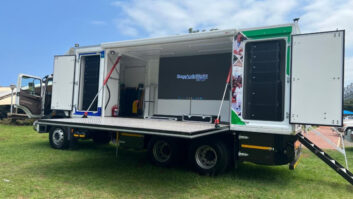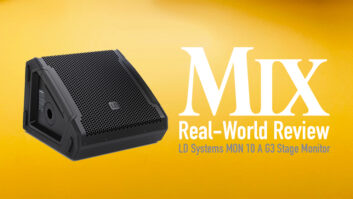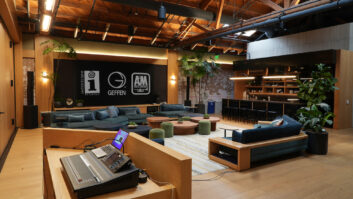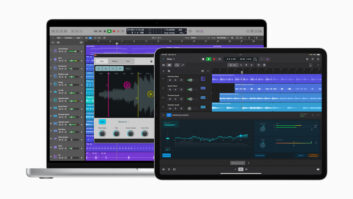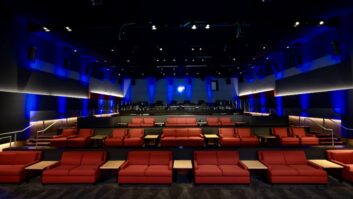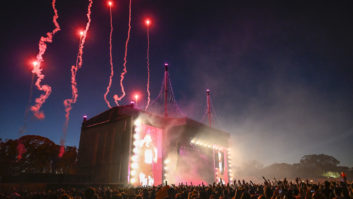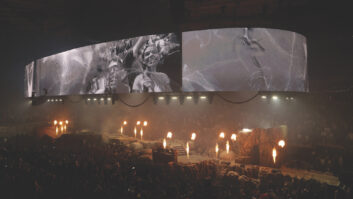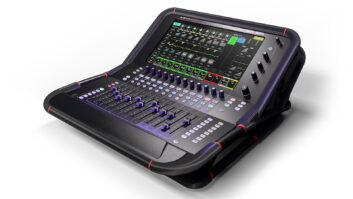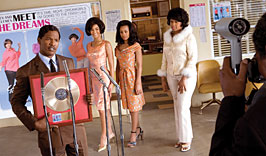
Nearly 25 years to the day after the musical Dreamgirls opened on Broadway and began a triumphant four-year run, a film version is finally hitting theaters. Its makers are no doubt hoping that some of the magic that propelled Chicago to great heights two years ago will rub off and help Dreamgirls make that always-difficult transition from stage to screen.
Dreamgirls has an awful lot going for it, including director Bill Condon, who was Oscar-nominated for writing the screenplay for Chicago (and won earlier for another film he directed, Gods and Monsters), and a fantastic cast including marquee players such as Jamie Foxx, Eddie Murphy, Beyoncé Knowles and Danny Glover, with soon-to-be-household names Jennifer Hudson (of American Idol fame), Sharon Leal and Anika Noni Rose. The story follows the rise of a Supremes-like group of female singers from their humble roots in Detroit’s black clubs to crossover stardom during the 1960s and ’70s, with plenty of pitfalls along the way. It’s loaded top to bottom with soulful songs (music by Henry Krieger, lyrics by Tom Eyen), the best known of which is “And I Am Telling You I’m Not Going,” which turned Jennifer Holliday into a star overnight, and may well do the same for the big-voiced Hudson.
Spearheading the post-production sound team for Dreamgirls at Technicolor Sound Services and Todd-AO West were supervising sound editor Richard Yawn (Fearless, Condon’s Kinsey, et al), and re-recording mixers Mike Minkler (a two-time Oscar winner, including Chicago, and nine-time nominee) and Bob Beemer (a three-time Oscar winner, most recently for Ray).

At Todd-AO West Stage 1, from left: re-recording mixer Mike Minkler, sound editor Richard Yawn and re-recording mixer Bob Beemer
“Musicals by nature are an awful lot of work because there’s so much music and so much pre-recording, live recording and post recording, and many different locations and environments,” says Minkler, who mixed the film’s dialog and music. “The full musical production has probably been going on for a year or year-and-a-half, and is being produced by a group called The Underdogs [Harvey Mason Jr. and Damon Thomas]. The music has gone through various stages of being sweetened — changing out drum tracks or bass lines, things of that nature — and then there’s also an original score that’s being done [by Stephen Trask and Paul Rabjohns], too. So it’s a huge challenge, and, of course, we’re always trying to get the best performance we can out of the vocals while still maintaining sync — because if it doesn’t look good in sync, you’re going to lose the moment. It’s tough to have the precision that you need and the dramatics that you need and the musical quality you need. It’s a combination that’s very difficult to attain.”
Minkler notes that Dreamgirls has 32 numbers in it — more than Chicago — “and with that amount of music, when you play it big and full and rich, cue after cue after cue, making it sound as good as you can make it sound can get tiresome; it’s tough to take that for two hours. So we’re not doing that. We’re cutting away from music a lot — there are performances onstage and we’ll cut backstage a lot for dramatic reasons to keep the story going and to vary it. Then there are different locales — small nightclubs, recording studios, theaters, a garage — so without degrading a beautiful musical sound, we do like to put the music into the location, too, so it’s not the same sound all through the film. It’s done with choices of reverb and different spaces within the mix. Plus, since we’re in a 5.1 environment, we use that to our advantage as much as we can by going small and big.”
Among the processors Minkler and Beemer used on the Todd-AO stage were the TC Electronic System 6000 and the Lexicon 480 and 980. Their desk is a Euphonix System 5, which Minkler says is “absolutely my console of choice. I have worked on other ones, of course, but I prefer this. [Euphonix has] a version coming out with new software, and I’m excited about that.”
According to effects mixer Beemer, “On this show, for me the biggest challenge was the crowds. There are lots and lots of performances and crowd scenes, and crowds are one of the hardest things you can do, mixing-wise. There’s a lot of shrieking and yelling, but at the same time, you have to make these artificial recordings sound organic to what you’re looking at. So that’s what I’ve been trying to do with dozens, maybe hundreds, of crowd elements recorded who-knows-where.”
Supervisor Yawn, who collected most of the crowd sounds from Technicolor Sound Services’ extensive libraries, says, “We were using a variety of recordings we had, as well as material we gathered from four group ADR sessions. [Robert Ulrich was ADR supervisor; Doc Kane and Greg Steele the ADR mixers.] The idea is for the crowd to be very interactive with the performers. I listened to a lot of other live-recorded performances on DVD to get a sense of what sort of things poke through in between lyrics and things like that. With that information, we then went and recorded in a warehouse at Technicolor to get the ambience we needed and specific call-outs, like where you hear someone calling out one of the girl’s name. That helped liven things up a lot because you can’t just have beds of cheers constantly — it tends to smear. You want the big cheer, but there are also ways of selling it with specific sounds and whistles.”

Beemer notes that there was no crowd sound from the set: “The extras were quiet but acting animated, so it was important to get the added crowds right. At the beginning, there are specifically small, black crowds and they’re very vocal, super-boisterous and fun, and then later on they go to the Copacabana and they’re attempting the crossover for all these conservative white people with flat-top crew cut hairdos and horn-rimmed glasses, and that crowd has a totally different feel, of course. By the end, when the Dreamgirls are playing larger venues, it’s a very respectful, mixed black-and-white crowd with a black-tie audience, so it lends itself to medium hooting and hollering. Each of these places had to have its own sound and feeling, and basically had to be made from scratch, from wild to elegant.
“Richard [Yawn] would give me the various crowd elements, and then we made sure that people are yelling at the right times and not stepping on Jennifer Hudson when she’s belting something out,” Beemer continues. “I got lots and lots of individual voices, calling out their names or whatnot, or cheering or hooting, and sometimes I’d get left-right pairs of maybe eight people cheering. Then it became a matter of orchestrating the voices in a sense; plus, you have to put them into the five channels so they’re in the surround speakers at the right time. It’s really fun: It’s like the crowd has to be a living animal that behaves in a certain way.”
Yawn and company also had to deal with specific period sound elements. “Of course, we were using ’60s and ’70s cars, but it’s also a lot of background ambience sounds that have to be right: the phone rings, the typewriters,” Yawn says. “Early in the film the typewriters are older-sounding manuals, and then when we’re into the ’70s, they’re IBM Selectrics. That’s one way you help sell the period and passage of time. Still, you never want to bury the music, because the music is king in this film — it’s all about the music and lyrics.”
And though the film is not nearly as stylized as, say, Chicago, Yawn says that he and Beemer were able to go “a little broader in certain areas” with sound effects than in a conventional dramatic film. “Some of what we do is going to be dictated by the editing [by Virginia Katz] and some of it is from the cinematography [by Tobias Schliessler], which is amazing,” Yawn says. “There are certain light flares as we intro into a performance, which allow us to use whoosh-type sound effects to accentuate certain types of camera shots, but then in other places, we wanted it more reality-based, so it doesn’t sound quite so much like a prerecord or a staged event. The other key was to try to find sounds that work well with the music rhythmically, especially in transitions in and out of songs. In one particular song, we finish a song — ‘Fake Your Way to the Top’ — and at the end we punch on a close-up of a musician playing the trumpet and then the next shot is a new scene with a car going by, so we put a Doppler car horn sound of the car going by in the same pitch coming out of the trumpet so it blends together really well. In the opening of the film, too, it starts with the logo and we have the crowds starting to fade up in reverb and then we have rhythmic clapping and stomps, which then time out in beat to the drum beat at the beginning of the [first] song. Bill [Condon] encouraged us all to come up with interesting ways of dealing with the sound and music, and I think it’s come out really well.”
The veteran Minkler agrees: “It’s really solid on every level. Scene after scene. It’s going to deliver.”
